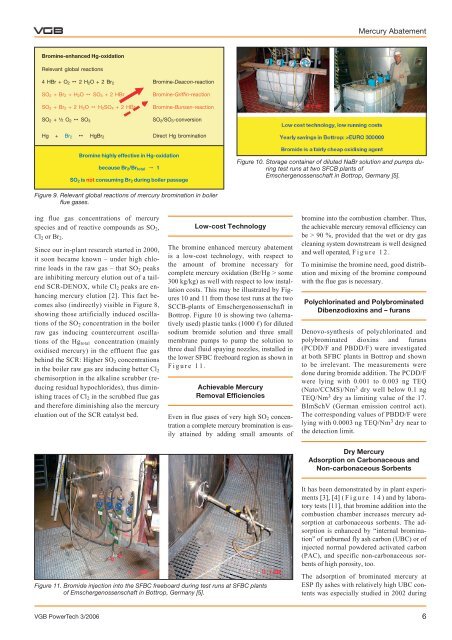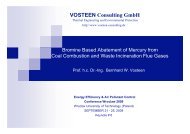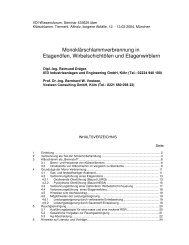Bromine-enhanced Mercury Abatement from Combustion Flue Gases
Bromine-enhanced Mercury Abatement from Combustion Flue Gases
Bromine-enhanced Mercury Abatement from Combustion Flue Gases
Create successful ePaper yourself
Turn your PDF publications into a flip-book with our unique Google optimized e-Paper software.
Figure 9. Relevant global reactions of mercury bromination in boiler<br />
flue gases.<br />
ing flue gas concentrations of mercury<br />
species and of reactive compounds as SO2,<br />
Cl2 or Br2.<br />
Since our in-plant research started in 2000,<br />
it soon became known – under high chlorine<br />
loads in the raw gas – that SO2 peaks<br />
are inhibiting mercury elution out of a tailend<br />
SCR-DENOX, while Cl2 peaks are enhancing<br />
mercury elution [2]. This fact becomes<br />
also (indirectly) visible in Figure 8,<br />
showing those artificially induced oscillations<br />
of the SO2 concentration in the boiler<br />
raw gas inducing countercurrent oscillations<br />
of the Hgtotal concentration (mainly<br />
oxidised mercury) in the effluent flue gas<br />
behind the SCR: Higher SO2 concentrations<br />
in the boiler raw gas are inducing better Cl2<br />
chemisorption in the alkaline scrubber (reducing<br />
residual hypochlorides), thus diminishing<br />
traces of Cl2 in the scrubbed flue gas<br />
and therefore diminishing also the mercury<br />
eluation out of the SCR catalyst bed.<br />
Low-cost Technology<br />
The bromine <strong>enhanced</strong> mercury abatement<br />
is a low-cost technology, with respect to<br />
the amount of bromine necessary for<br />
complete mercury oxidation (Br/Hg > some<br />
300 kg/kg) as well with respect to low installation<br />
costs. This may be illustrated by Figures<br />
10 and 11 <strong>from</strong> those test runs at the two<br />
SCCB-plants of Emschergenossenschaft in<br />
Bottrop. Figure 10 is showing two (alternatively<br />
used) plastic tanks (1000 �) for diluted<br />
sodium bromide solution and three small<br />
membrane pumps to pump the solution to<br />
three dual fluid spaying nozzles, installed in<br />
the lower SFBC freeboard region as shown in<br />
Figure 11.<br />
Achievable <strong>Mercury</strong><br />
Removal Efficiencies<br />
Even in flue gases of very high SO2 concentration<br />
a complete mercury bromination is easily<br />
attained by adding small amounts of<br />
Figure 11. Bromide injection into the SFBC freeboard during test runs at SFBC plants<br />
of Emschergenossenschaft in Bottrop, Germany [5].<br />
<strong>Mercury</strong> <strong>Abatement</strong><br />
Figure 10. Storage container of diluted NaBr solution and pumps during<br />
test runs at two SFCB plants of<br />
Emschergenossenschaft in Bottrop, Germany [5].<br />
bromine into the combustion chamber. Thus,<br />
the achievable mercury removal efficiency can<br />
be > 90 %, provided that the wet or dry gas<br />
cleaning system downstream is well designed<br />
and well operated, Figure 12.<br />
To minimise the bromine need, good distribution<br />
and mixing of the bromine compound<br />
with the flue gas is necessary.<br />
Polychlorinated and Polybrominated<br />
Dibenzodioxins and – furans<br />
Denovo-synthesis of polychlorinated and<br />
polybrominated dioxins and furans<br />
(PCDD/F and PBDD/F) were investigated<br />
at both SFBC plants in Bottrop and shown<br />
to be irrelevant. The measurements were<br />
done during bromide addition. The PCDD/F<br />
were lying with 0.001 to 0.003 ng TEQ<br />
(Nato/CCMS)/Nm 3 dry well below 0.1 ng<br />
TEQ/Nm 3 dry as limiting value of the 17.<br />
BImSchV (German emission control act).<br />
The corresponding values of PBDD/F were<br />
lying with 0.0003 ng TEQ/Nm 3 dry near to<br />
the detection limit.<br />
Dry <strong>Mercury</strong><br />
Adsorption on Carbonaceous and<br />
Non-carbonaceous Sorbents<br />
It has been demonstrated by in plant experiments<br />
[3], [4] (Figure 14) and by laboratory<br />
tests [11], that bromine addition into the<br />
combustion chamber increases mercury adsorption<br />
at carbonaceous sorbents. The adsorption<br />
is <strong>enhanced</strong> by “internal bromination”<br />
of unburned fly ash carbon (UBC) or of<br />
injected normal powdered activated carbon<br />
(PAC), and specific non-carbonaceous sorbents<br />
of high porosity, too.<br />
The adsorption of brominated mercury at<br />
ESP fly ashes with relatively high UBC contents<br />
was especially studied in 2002 during<br />
VGB PowerTech 3/2006 6





